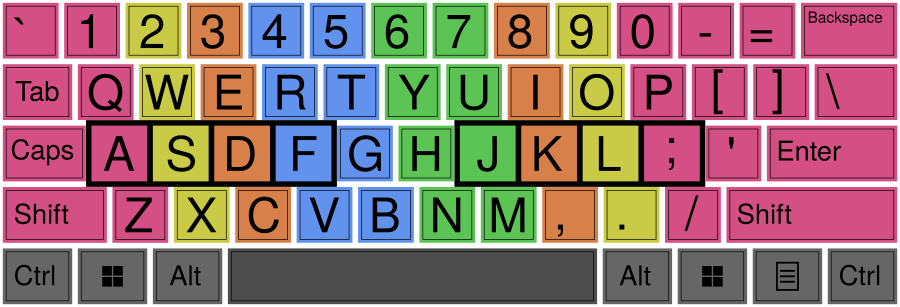Author: PinkWrite
Little Ida’s Flowers
by Hans Christian Andersen (1835)
The Swineherd
by Hans Christian Andersen (1842)
The Ugly Duckling
by Hans Christian Andersen (1844)
The Fir Tree
by Hans Christian Andersen (1845)
The Nightingale
by Hans Christian Andersen (1844)
Thumbelina (Little Tiny)
by Hans Christian Andersen (1835)
The Travelling Companion
by Hans Christian Andersen (1835)
The Little Mermaid
by Hans Christian Andersen (1836)
What the Moon Saw
by Hans Christian Andersen (1840)
de Finibus Bonorum et Malorum
Lorum Ipsum
Capitalization
202 Adjectives
Taiwan’s Biggest Secret 台灣的最大祕辛
PinkWrite | Do English v1.0 Released!
303 Verbs
Doc on Google Drive | Simple HTML | 303 Verbs Scroll App
*Practice Person and Voice. (For Passive Voice, use Perfect sentences and verbs with ‘been’ or Gerund sentences with Perfect verbs.)
Continue reading
181 Sight Words
131 Sound Words
88 Typing Words
Doc on Google Drive | Simple HTML | 88-Word Hanon App | GitHub
Keyboard vectors on Google Drive: PDF | SVG | SVG-TEXT
The Word Hanon 88 typing method is a perfect place to begin! This app’s typing area disables drag-and-drop, cut, paste, and auto-word-completion so that students can’t cheat! Copy is still enabled so students can keep a record of their progress.
 (After learning to type with proper fingers, the PinkWrite 99 typing box is an excellent tool for basic typing composition!)
(After learning to type with proper fingers, the PinkWrite 99 typing box is an excellent tool for basic typing composition!)
Keyboard is a technique, whether typing or playing piano.
Firstly, practice these using correct fingers:
- asdfjkl;
- qweruiop
- zxcvm,./
- asdfghjkl;’
- qwertyuiop[]\
- zxcvbnm,./
- `1234567890-=
Then, practice these 88 words, in order, about 50 times each…
To keep improving typing, do numbers zero through twenty, then colors, then other basic vocabulary, then short sentences. After all that, you can be very good at “sight typing”.
Continue reading
WH – Relative and Interrogative Clauses
14 Pronouns
Verb Tense & Mood
Noun Case
How the Whale Got His Throat
Doc on Google Drive | Simple HTML
Rudyard Kipling (1902)
Edited by Jesse Steele
In the sea, once upon a time, O my Best Beloved, there was a Whale, and he ate fishes. He ate the starfish and the garfish, and the crab and the dab, and the plaice and the dace, and the skate and his mate, and the mackereel and the pickereel, and the really truly twirly-whirly eel. All the fishes he could find in all the sea he ate with his mouth—so! Till at last there was only one small fish left in all the sea, and he was a small Astute Fish, and he swam a little behind the Whale’s right ear, so as to be out of harm’s way. Then the Whale stood up on his tail and said, “I’m hungry.” And the small Astute Fish said in a small astute voice, “Noble and generous Cetacean, have you ever tasted Man?”
“No,” said the Whale. “What is it like?”
“Nice,” said the small Astute Fish. “Nice but nubbly.”
“Then fetch me some,” said the Whale, and he made the sea froth up with his tail. Continue reading
How the Rhinoceros Got His Skin
Doc on Google Drive | Simple HTML
Rudyard Kipling (1902)
Edited by Jesse Steele
Once upon a time, on an uninhabited island on the shores of the Red Sea, there lived a Parsee (having a very mystical sentiency) from whose hat the rays of the sun were reflected in more-than-oriental splendour. And the Parsee lived by the Red Sea with nothing but his hat and his knife and a cooking-stove of the kind that you must particularly never touch. And one day he took flour and water and currants and plums and sugar and things, and made himself one cake which was two feet across and three feet thick. It was indeed a Superior Comestible (that’s magic), and he put it on the stove because he was allowed to cook on that stove, and he baked it and he baked it till it was all done brown and smelt most sentimental. But just as he was going to eat it there came down to the beach from the Altogether Uninhabited Interior one Rhinoceros with a horn on his nose, two piggy eyes, and few manners. In those days the Rhinoceros’s skin fitted him quite tight. There were no wrinkles in it anywhere. He looked exactly like a Noah’s Ark Rhinoceros, but of course much bigger. All the same, he had no manners then, and he has no manners now, and he never will have any manners. He said, “How!” and the Parsee left that cake and climbed to the top of a palm tree with nothing on but his hat, from which the rays of the sun were always reflected in more-than-oriental splendour. And the Rhinoceros upset the oil-stove with his nose, and the cake rolled on the sand, and he spiked that cake on the horn of his nose, and he ate it, and he went away, waving his tail, to the desolate and Exclusively Uninhabited Interior which abuts on the islands of Mazanderan, Socotra, and the Promontories of the Larger Equinox. Then the Parsee came down from his palm-tree and put the stove on its legs and recited the following Sloka, which, as you have not heard, I will now proceed to relate:— Continue reading
How the Camel Got His Hump
Doc on Google Drive | Simple HTML
Rudyard Kipling (1902)
Edited by Jesse Steele
Now this is the next tale, and it tells how the Camel got his big hump.
In the beginning of years, when the world was so new and all, and the Animals were just beginning to work for Man, there was a Camel, and he lived in the middle of a Howling Desert because he did not want to work; and besides, he was a Howler himself. So he ate sticks and thorns and tamarisks and milkweed and prickles, most excruciating idle; and when anybody spoke to him he said “Humph!” Just “Humph!” and no more.
Presently the Horse came to him on Monday morning, with a saddle on his back and a bit in his mouth, and said, “Camel, O Camel, come out and trot like the rest of us.”
“Humph!” said the Camel; and the Horse went away and told the Man. Continue reading
How the Leopard Got His Spots
Doc on Google Drive | Simple HTML
Rudyard Kipling (1902)
Edited by Jesse Steele
In the days when everybody started fair, Best Beloved, the Leopard lived in a place called the High Veldt. “Rember it wasn’t the Low Veldt, or the Bush Veldt, or the Sour Veldt, but the exclusively bare (quite exclusively bare), hot, shiny High Veldt, where there was sand and sandy-colored rock and exclusively tufts of sandy-yellowish grass. The Giraffe (with his exclusively tall neck) and the Zebra (who appears exclusively like static) and the Eland (with his exclusively fat neck) and the Koodoo (with his exclusively bulging ears) and the Hartebeest (with his exclusively long face) lived there; and they were exclusively sandy-yellow-brownish all over; but the Leopard, he was the exclusivest (most exclusive of all) sandiest-yellowish-brownest of them all—a grayish-yellowish catty-shaped kind of beast, and he matched the exclusively yellowish-grayish-brownish color of the High Veldt to one hair. This was very bad for the Giraffe and the Zebra and the rest of them; for he would lie down by an exclusively yellowish-grayish-brownish stone or clump of grass, and when the Giraffe or the Zebra or the Eland or the Koodoo or the Bush-Buck or the Bonte-Buck came by he would surprise them out of their jumpsome lives. He would indeed! And, also, there was an Ethiopian with bows and arrows (an exclusively grayish-brownish-yellowish man he was then), who lived on the High Veldt with the Leopard; and the two used to hunt together—the Ethiopian with his bows and arrows, and the Leopard exclusively with his teeth and claws—till the Giraffe and the Eland and the Koodoo and the Quagga and all the rest of them didn’t know which way to jump, Best Beloved. They didn’t indeed!
After a long time—things lived for ever so long in those days—they learned to avoid anything that looked like a Leopard or an Ethiopian; and bit by bit—the Giraffe began it, because his legs were the longest—they went away from the High Veldt. They scuttled for days and days and days till they came to a great forest, exclusively full of trees and bushes and stripy, speckly, patchy-blatchy shadows, and there they hid: and after another long time, what with standing half in the shade and half out of it, and what with the slippery-slidy shadows of the trees falling on them, the Giraffe grew blotchy, and the Zebra grew stripy, and the Eland and the Koodoo grew darker, with little wavy grey lines on their backs like bark on a tree trunk; and so, though you could hear them and smell them, you could very seldom see them, and then only when you knew precisely where to look. They had a beautiful time in the exclusively speckly-spickly shadows of the forest, while the Leopard and the Ethiopian ran about over the exclusively grayish-yellowish-reddish High Veldt outside, wondering where all their breakfasts and their dinners and their teas had gone. At last they were so hungry that they ate rats and beetles and rock-rabbits, the Leopard and the Ethiopian, and then they had the Big Tummy-ache, both together; and then they met Baviaan—the dog-headed, barking Baboon, who is Quite the Wisest Animal in All South Africa.
Said Leopard to Baviaan (and it was a very hot day), “Where has all the game gone?” Continue reading
The Cat that Walked by Himself
Doc on Google Drive | Simple HTML
Rudyard Kipling (1902)
Edited by Jesse Steele
Hear and attend and listen; for this befell and behappened and became and was, O my Best Beloved, when the Tame animals were wild. The Dog was wild, and the Horse was wild, and the Cow was wild, and the Sheep was wild, and the Pig was wild—as wild as wild could be—and they walked in the Wet Wild Woods by their wild lones. But the wildest of all the wild animals was the Cat. He walked by himself, and all places were alike to him.
Of course the Man was wild too. He was dreadfully wild. He didn’t even begin to be tame till he met the Woman, and she told him that she did not like living in his wild ways. She picked out a nice dry Cave, instead of a heap of wet leaves, to lie down in; and she strewed clean sand on the floor; and she lit a nice fire of wood at the back of the Cave; and she hung a dried wild-horse skin, tail-down, across the opening of the Cave; and she said, “Wipe you feet, dear, when you come in, and now we’ll keep house.” Continue reading
